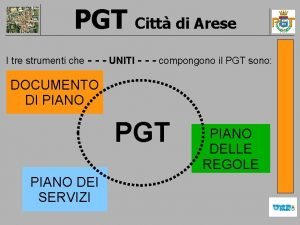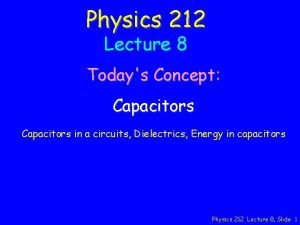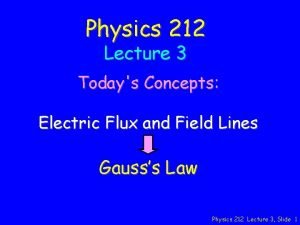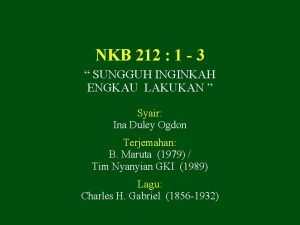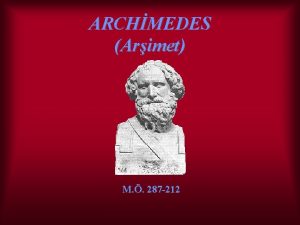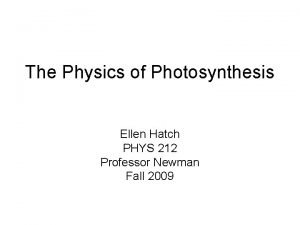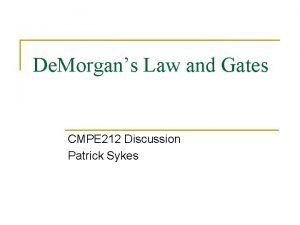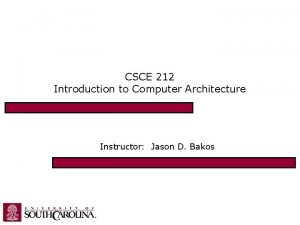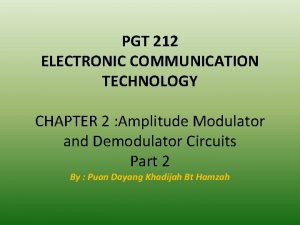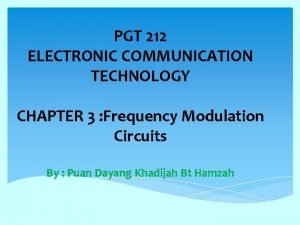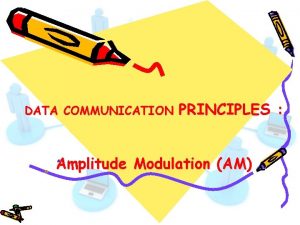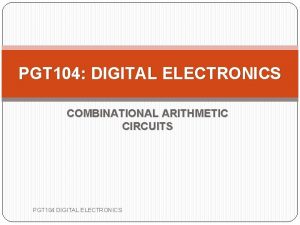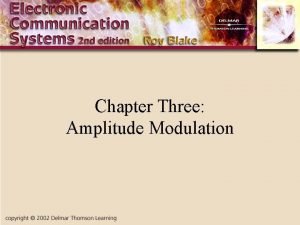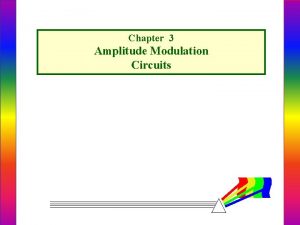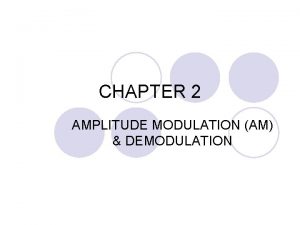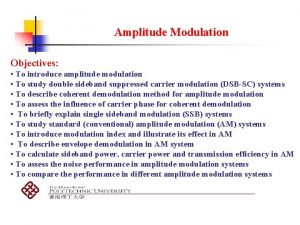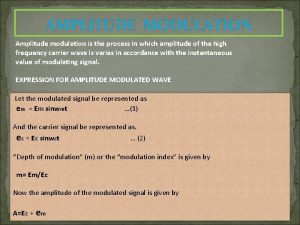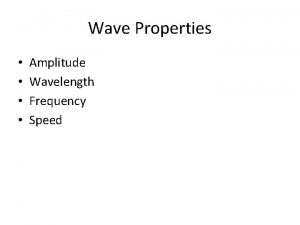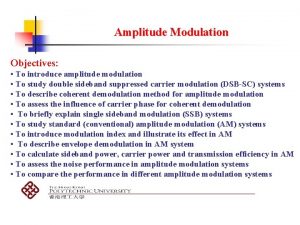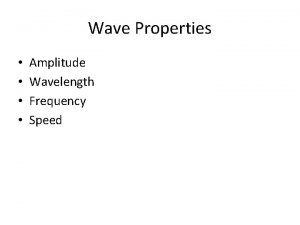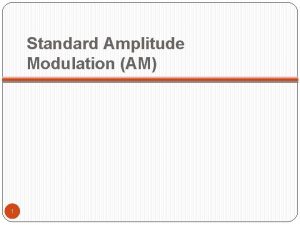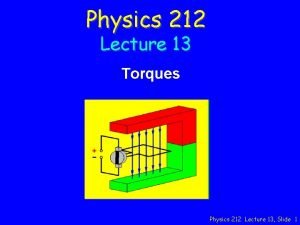PGT 212 ELECTRONIC COMMUNICATION TECHNOLOGY CHAPTER 2 Amplitude







































- Slides: 39

PGT 212 ELECTRONIC COMMUNICATION TECHNOLOGY CHAPTER 2 : Amplitude Modulator and Demodulator Circuits Part 2 By : Puan Dayang Khadijah Bt Hamzah

Basic Principles of Amplitude Modulation • Modulator circuits cause carrier amplitude to be varied in accordance with modulating signals. Circuits produce AM, DSB, and SSB transmission methods. • The basic equation for an AM signal is νAM = Vcsin 2πfct + (Vmsin 2πfmt)(sin 2πfct) • The first term is the sine wave carrier • The second term is the product of the sine wave carrier and modulating signals.

AM in the Time Domain – Amplitude modulation voltage is produced by a circuit that can multiply the carrier by the modulating signal and then add the carrier. – If a circuit’s gain is a function of 1+ m sin 2πfmt, the expression for the AM signal is νAM = A(νc) Where A is the gain or attenuation factor.

Generation of AM Signal Block diagram of a circuit to produce AM

AM in the Frequency Domain – The product of the carrier and modulating signal can be generated by applying both signals to a nonlinear component such as a diode. – A square-law function is one that varies in proportion to the square of the input signals. A diode gives a good approximation of a square-law response. Bipolar and field-effect transistors (FETs) can also be biased to give a square-law response. – Diodes and transistors whose function is not a pure square-law function produce third-, fourth-, and higher-order harmonics, which are sometimes referred to as intermodulation products. – Intermodulation products are easy to filter out. – Tuned circuits filter out the modulating signal and carrier harmonics, leaving only carrier and sidebands.

A square-law circuit for producing AM. AM signal containing not only the carrier and sidebands but also the modulating signal.

Tuned circuit filters Figure 4 -6 The tuned circuit filters out the modulating signal and carrier harmonics, leaving only the carrier and sidebands.

Amplitude Modulators • There are two types of amplitude modulators. They are low-level and high-level modulators. • Low-level modulators generate AM with small signals and must be amplified before transmission. • High-level modulators produce AM at high power levels, usually in the final amplifier stage of a transmitter.

Low-Level AM: Diode Modulator – Diode modulation consists of a resistive mixing network, a diode rectifier, and an LC tuned circuit. – The carrier is applied to one input resistor and the modulating signal to another input resistor. – This resistive network causes the two signals to be linearly mixed (i. e. algebraically added). – A diode passes half cycles when forward biased. – The coil and capacitor repeatedly exchange energy, causing an oscillation or ringing at the resonant frequency.

Amplitude Modulators Circuit Figure 4 -7 Amplitude modulation with a diode.

Low-Level AM: Transistor Modulator – Transistor modulation consists of a resistive mixing network, a transistor, and an LC tuned circuit. – The emitter-base junction of the transistor serves as a diode and nonlinear device. – Modulation and amplification occur as base current controls a larger collector current. – The LC tuned circuit oscillates (rings) to generate the missing half cycle.

Transistor Modulator Circuit Figure 4 -9 Simple transistor modulator.

Low-Level AM: PIN Diode Modulator – Variable attenuator circuits using PIN diodes produce AM at VHF, UHF, and microwave frequencies. – PIN diodes are special type silicon junction diodes designed for use at frequencies above 100 MHz. – When PIN diodes are forward-biased, they operate as variable resistors. – Attenuation caused by PIN diode circuits varies with the amplitude of the modulating signal.

PIN Diode Modulator Circuit Figure 4 -10 High-frequency amplitude modulators using PIN diodes.

Low-Level AM: Differential Amplifier – Differential amplifier modulators make excellent amplitude modulators because they have a high gain, good linearity and can be 100 percent modulated. – The output voltage can be taken between two collectors, producing a balanced, or differential, output. – The output can also be taken from the output of either collector to ground, producing a singleended output.

Low-Level AM: Differential Amplifier – The modulating signal is applied to the base of a constant-current source transistor. – The modulating signal varies the emitter current and therefore the gain of the circuit. – The result is AM in the output.

Differential Amplifier Circuit (LL) Figure 4 -11 (a) Basic differential amplifier. (b) Differential amplifier modulator.

High-Level AM – In high-level modulation, the modulator varies the voltage and power in the final RF amplifier stage of the transmitter. – The result is high efficiency in the RF amplifier and overall high-quality performance. High-Level AM: Collector Modulator – The collector modulator is a linear power amplifier that takes the low-level modulating signals and amplifies them to a high-power level. – A modulating output signal is coupled through a modulation transformer to a class C amplifier. – The secondary winding of the modulation transformer is connected in series with the collector supply voltage of the class C amplifier.

High-level collector Circuit Figure 4 -13 A high-level collector modulator.

High-Level AM: Series Modulator – A series modulator produces high-level modulation without a large and expensive modulation transformer used in collector modulators. – It improves frequency response. – It is, however, very inefficient. – A series modulator replaces the modulation transformer with an emitter follower. – The modulating signal is applied to the emitter follower. – The emitter follower is in series with the collector supply voltage. – The collector voltage changes with variations in the amplified audio modulating signal.

Series Modulator Circuit Figure 4 -15 Series modulation. Transistors may also be MOSFETs with appropriate biasing.

Amplitude Demodulators cont (3 April 2015) • Demodulators, or detectors, are circuits that accept modulated signals and recover the original modulating information. Figure : A diode detector AM demodulator.

Diode Detector – On positive alternations of the AM signal, the capacitor charges quickly to the peak value of pulses passed by the diode. – When the pulse voltage drops to zero, the capacitor discharges into the resistor. – The time constant of the capacitor and resistor is long compared to the period of the carrier. – The capacitor discharges only slightly when the diode is not conducting. – The resulting waveform across the capacitor is a close approximation to the original modulating signal.

Cont: – Because the diode detector recovers the envelope of the AM (modulating) signal, the circuit is sometimes called an envelope detector. – If the RC time constant in a diode detector is too long, the capacitor discharge will be too slow to follow the faster changes in the modulating signal. – This is referred to as diagonal distortion.

Synchronous Detection – Synchronous detectors use an internal clock signal at the carrier frequency in the receiver to switch the AM signal off and on, producing rectification similar to that in a standard diode detector. – Synchronous detectors or coherent detectors have less distortion and a better signal-to-noise ratio than standard diode detectors. – The key to making the synchronous detector work is to ensure that the signal producing the switching action is perfectly in phase with the received AM carrier. – An internally generated carrier signal from an oscillator will not work.

Synchronous detector circuit Figure 4 -22 A practical synchronous detector.

Balanced Modulator • A balanced modulator is a circuit that generates a DSB signal, suppressing the carrier and leaving only the sum and difference frequencies at the output. • The output of a balanced modulator can be further processed by filters or phase-shifting circuitry to eliminate one of the sidebands, resulting in a SSB signal. • Types of balanced modulators include lattice, 1496/1596 IC, and the analog multiplier.

1. Lattice Modulator – A popular and widely used balanced modulator is the diode ring or lattice modulator. – The lattice modulator consists of an input transformer, an output transformer and four diodes connected in a bridge circuit. – The carrier signal is applied to the center taps of the input and output transformers. – The modulating signal is applied to the input transformer. – The output appears across the output transformer.

Lattice Modulator Circuit Lattice-type balanced modulator.

Lattice Modulators : Explanation – The carrier sine wave is considerably higher in frequency and amplitude than the modulating signal. – The carrier sine wave is used as a source of forward and reverse bias for the diodes. – The carrier turns the diodes off and on at a high rate of speed. – The diodes act like switches that connect the modulating signal at the secondary of T 1 to the primary of T 2.

2. IC Balanced Modulators – The 1496/1596 IC is a versatile circuit available for communication applications. – It can work at carrier frequencies up to 100 MHz. – It can achieve a carrier suppression of 50 to 65 d. B. – The 1496/1596 IC can operate as a balanced modulator or configured to perform as an amplitude modulator, a product detector, or a synchronous detector.

Analog Multiplier – An analog multiplier is a type of integrated circuit that can be used as a balanced modulator. – Analog multipliers are often used to generate DSB signals. – The analog multiplier is not a switching circuit like the balanced modulator. – The analog multiplier uses differential amplifiers operating in the linear mode. – The carrier must be a sine wave and the multiplier produces the true product of two analog inputs.

SSB Circuits Generating SSB Signals: The Filter Method – The filter method is the simplest and most widely used method of generating SSB signals. – The modulating signal is applied to the audio amplifier. – The amplifier’s output is fed to one input of a balanced modulator. – A crystal oscillator provides the carrier signal which is also applied to the balanced modulator. – The output of the balanced modulator is a doublesideband (DSB) signal. – An SSB signal is produced by passing the DSB signal through a highly selective bandpass filter. – With the filter method, it is necessary to select either the upper or the lower sideband.

SSB Circuits Figure 4 -31 An SSB transmitter using the filter method.

Generating SSB Signals: Phasing Method – The phasing method of SSB generation uses a phaseshift technique that causes one of the sidebands to be canceled out. – The phasing method uses two balanced modulators which eliminate the carrier. – The carrier oscillator is applied to the upper balanced modulator along with the modulating signal. – The carrier and modulating signals are both shifted in phase by 90 degrees and applied to another balanced modulator. – Phase-shifting causes one sideband to be canceled out when the two modulator outputs are added together.

SSB Circuits: Phasing Method Figure 4 -33 An SSB generator using the phasing method.

DSB and SSB Demodulation – To recover the intelligence in a DSB or SSB signal, the carrier that was suppressed at the receiver must be reinserted. – A product detector is a balanced modulator used in a receiver to recover the modulating signal. – Any balanced modulator can be used as a product detector to demodulate SSB signals.

A balanced modulator used as a product detector to demodulate an SSB signal

END of CHAPTER 2
 Pgt travacò siccomario
Pgt travacò siccomario Pgt martinengo
Pgt martinengo Pgt arese
Pgt arese Pgt vedano olona
Pgt vedano olona Pgt almenno san bartolomeo
Pgt almenno san bartolomeo Pgt mandello del lario
Pgt mandello del lario Is the electronic exchange of money or scrip
Is the electronic exchange of money or scrip Electronic news gathering and electronic field production
Electronic news gathering and electronic field production Physics 212 gradebook
Physics 212 gradebook Physics 212 gradebook
Physics 212 gradebook Pese 212
Pese 212 Nkb 212 sungguh inginkah engkau lakukan
Nkb 212 sungguh inginkah engkau lakukan Ienf-212
Ienf-212 Et 212
Et 212 Et 212
Et 212 12345 6789 10
12345 6789 10 Archimedes ( arşimet) (mö 287–212 )
Archimedes ( arşimet) (mö 287–212 ) 212 bc
212 bc Phys 212 equation sheet
Phys 212 equation sheet 212 instalaciones tecnicas ejemplos
212 instalaciones tecnicas ejemplos Ckdiv
Ckdiv Có 3 thùng dầu mỗi thùng chứa 125l tóm tắt
Có 3 thùng dầu mỗi thùng chứa 125l tóm tắt Menunjukkan hubungan antara suhu dengan pemuaian benda
Menunjukkan hubungan antara suhu dengan pemuaian benda Naca 2412
Naca 2412 Tipos de dique de hule
Tipos de dique de hule Cls 212
Cls 212 Naca 65-006
Naca 65-006 Sfsu cls
Sfsu cls Cmpe 212
Cmpe 212 212
212 212
212 Cls 212
Cls 212 Ps 212 midtown west
Ps 212 midtown west Ables curriculum
Ables curriculum Arquimedes frase celebre
Arquimedes frase celebre Cls 212
Cls 212 Permeabilidad vascular
Permeabilidad vascular Special purpose diodes
Special purpose diodes Et 212
Et 212 Et 212
Et 212


